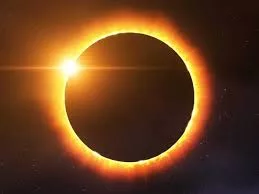
One of the most spectacular natural phenomena is coming to Texas this Saturday, October 14: a solar eclipse.
A solar eclipse is when the moon, in its orbit around the Earth, passes directly between the sun and the Earth, casting its shadow on the Earth. In a lucky coincidence, the moon and the sun appear to be the same size to us on Earth. The sun, of course, is much larger than the moon: about 400 times larger. But it is also about 400 times farther away, thus the apparent size is the same, and when the moon passes in front of the sun, it blocks out the sun perfectly. Most of the time…
Actually there are two types of solar eclipses: a “total eclipse,” and an “annular eclipse.” In a bit of good fortune, we will have one of each in Texas in the next six months. A total eclipse, which is the more spectacular of the two, will cross Texas on April 8, 2024. It will pass just south of Brownwood, but we will be so close to the path of totality that the sun will be blocked more than 99% by the moon here. Many cities in Texas have big festivals planned for that day. The Brownwood and Early ISD’s have purchased special eclipse glasses for all their students for that day.
The eclipse happening this Saturday is an “annular eclipse.” In this case the moon is just a little farther away from the Earth in its orbit, thus appearing to be slightly smaller than normal. As a result, it does not quite cover the whole sun. At the point of maximum eclipse, you can still see a thin strip of sun around the outer edge of the moon, a “ring of fire” so to speak. That is what the word “annular” means: a ring shape.
The annular eclipse will cross Texas in a northwest-to-southeast path, going from Midland-Odessa to San Angelo, Junction, San Antonio, and Corpus Christi. The moon’s shadow will travel more than 2,000 miles-per-hour across Texas. Here in Brownwood we will be just north of the path, but will still have about 90% coverage. If you want to see the full annular eclipse, however, you will need to travel to some point within the full eclipse path, as shown in this map.

You can find more detailed maps online. A good site is: greatamericaneclipse.com. Special eclipse glasses are absolutely mandatory for viewing the eclipse; without them permanent eye damage will occur. Eclipse glasses are probably available at local retail stores. You can buy them online also, but it may be too late to get them for this week’s eclipse.
The time of the eclipse will vary by location, of course. But nearest to here, the moon will first start moving in front of the sun about 10:21 a.m. The maximum part of the eclipse, the “annularity”, will begin about 11:49 a.m. and last about four minutes. The eclipse will end about 1:27 p.m., when the moon completes its pass in front of the sun, from our vantage point.
Don’t miss your chance to see these two eclipses in Texas. Statistically speaking, any one spot on Earth gets a solar eclipse about once every 300 years, on average. We are very fortunate to have two eclipses to see here. The next total eclipse in the United States will be August 12, 2045, crossing from California to Florida. It will pass just north of Texas, going from Colorado to Oklahoma and Arkansas, before exiting the U.S. at Florida. The next eclipse in Texas will be November 15, 2077, and it will be an annular eclipse.
So for many of us, these two eclipses will be the only ones we will have a chance to see in Texas in our lifetimes. Don’t miss it!